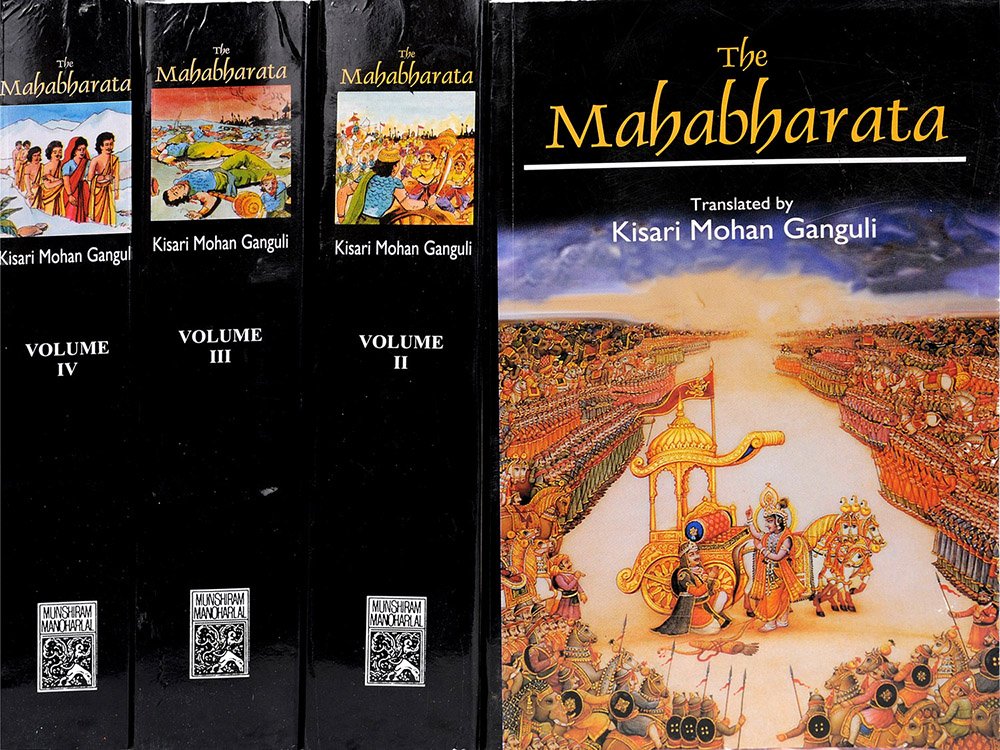Mahabharata (English)
by Kisari Mohan Ganguli | 2,566,952 words | ISBN-10: 8121505933
The English translation of the Mahabharata is a large text describing ancient India. It is authored by Krishna-Dwaipayana Vyasa and contains the records of ancient humans. Also, it documents the fate of the Kauravas and the Pandavas family. Another part of the large contents, deal with many philosophical dialogues such as the goals of life. Book...
Section LXXXIX
"Dhaumya continued,
'I shall describe to you those sacred spots capable of producing merit that lie on the west, in the country of the Anarttas, O Bharata, there, flows in a westward course the sacred river Narmada, graced by Priyangu and mango trees, and engarlanded with thickest of canes.
All the tirthas and sacred spots, and rivers and woods and foremost of mountains that are in the three worlds, all the gods with the Grandsire, along with the Siddhas, the Rishis and the Charanas, O best of the Kurus, always come, O Bharata, to bathe in the sacred waters of the Narmada. And it has been heard by us that the sacred asylum of the Muni Visravas, had stood there, and that there was born the lord of treasures, Kuvera, having men for his vehicles.
There also is that foremost of hills, the sacred and auspicious Vaidurya peak abounding with trees that are green and which are always graced with fruit and flowers. O lord of the earth, on the top of that mountain is a sacred tank decked with full-blown lotus and resorted to by the gods and the Gandharvas. Many are the wonders, O mighty monarch, that may be seen on that sacred mountain which is like unto heaven itself and which is visited by celestial Rishis.
There, O subjugator of hostile cities, is the sacred river called Visvamitra belonging to the royal sage of that name and which abounds, O king, in many sacred tirthas. It was on the banks of this river, that Yayati, the son of Nahusha, (fell from heaven) among the virtuous, and obtained once more the eternal regions of the righteous.
Here also are the well-known lake called Punya, the mountain called Mainaka, and that other mountain called Asita abounding in fruits and roots.
And here also is the sacred asylum of Kakshasena, and O Yudhishthira, the asylum of Cyavana also, which is famed over every country, O son of Pandu! In that spot, O exalted one, men attain to (ascetic) success without severe austerities.
Here also, O mighty king, is the region called Jamvumarga, inhabited by birds and deer, and which constitutes the retreat of ascetics with souls under control, O you foremost of those that have subdued their senses! Next lie the exceedingly sacred Ketumala, and Medhya ever graced with ascetics, and, O lord of earth, Gangadwara, and the well-known woods of Saindhava which are sacred and inhabited by the regenerate ones.
There also is the celebrated tank of the Grandsire, called Pushkara, the favourite abode of the Vaikanasas, and Siddhas and Rishis. Moved by the desire of obtaining its protection, the Creator sang this verse at Pushkara, O chief of the Kurus and foremost of virtuous men! If a person of pure soul purposes a pilgrimage to the Pushkaras in imagination even, he becomes purged from all his sins and rejoices in heaven!'"
Conclusion:
This concludes Section LXXXIX of Book 3 (Vana Parva) of the Mahabharata, of which an English translation is presented on this page. This book is famous as one of the Itihasa, similair in content to the eighteen Puranas. Book 3 is one of the eighteen books comprising roughly 100,000 Sanskrit metrical verses.
FAQ (frequently asked questions):
Which keywords occur in Section LXXXIX of Book 3 of the Mahabharata?
The most relevant definitions are: Rishis, Pushkara, Bharata, Narmada, tirthas, Siddhas; since these occur the most in Book 3, Section LXXXIX. There are a total of 33 unique keywords found in this section mentioned 43 times.
What is the name of the Parva containing Section LXXXIX of Book 3?
Section LXXXIX is part of the Tirtha-yatra Parva which itself is a sub-section of Book 3 (Vana Parva). The Tirtha-yatra Parva contains a total of 101 sections while Book 3 contains a total of 13 such Parvas.
Can I buy a print edition of Section LXXXIX as contained in Book 3?
Yes! The print edition of the Mahabharata contains the English translation of Section LXXXIX of Book 3 and can be bought on the main page. The author is Kisari Mohan Ganguli and the latest edition (including Section LXXXIX) is from 2012.
